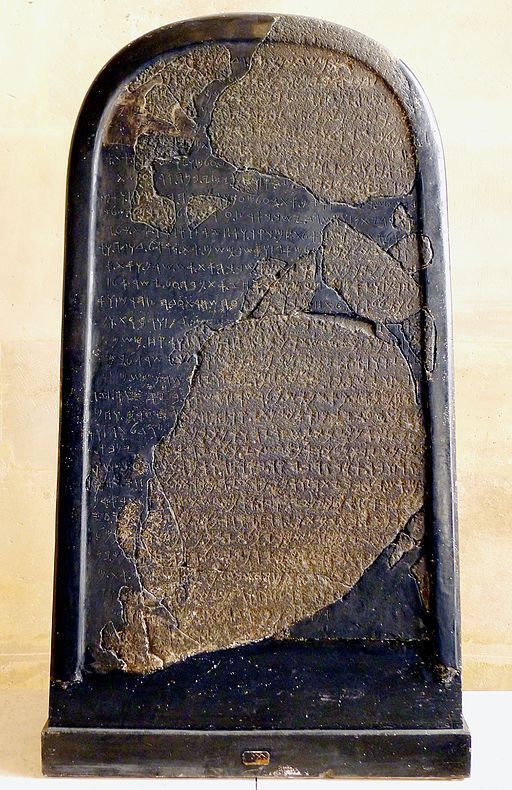
Mesha Stele. Does the Mesha Stele mention King David of the Bible in its 31st line? Scholars André Lemaire and Jean-Philippe Delorme think the “House of David” reading can now be confirmed. Photo: Mbzt 2012 / CC by 3.0.
Does the Mesha Stele mention King David of the Bible?
In the ninth century BCE, King Mesha of Moab set up a stela in his capital Dibon. It chronicled his military victories over his enemies, including Israel and possibly Judah, called the “House of David.” Unfortunately, the portion of the stela that might mention King David of the Bible—as the founder of Judah’s dynasty—has been damaged, which makes the reading of the “House of David” uncertain.
Before the Mesha Stele was damaged in 1869, a squeeze (paper-mache impression) of the inscription was made. New photographic evidence of the squeeze and the stone itself has convinced some scholars that it does indeed mention the “House of David,” the dynasty established by King David of the Bible. André Lemaire and Jean-Philippe Delorme examine the evidence for the “House of David” in the Mesha Stele in their article, “Mesha’s Stele and the House of David,” published in the Winter 2022 issue of Biblical Archaeology Review.
The Mesha Stele
Carved from black basalt, the Mesha Stele (also called the Moabite Stone) measures about 3 feet tall and 2 feet wide. It contains 34 lines of text, with the possible “House of David” reference appearing on its 31st line. King Mesha set up the victory stela in his capital, Dibon (modern Dhiban in Jordan).
The Mesha Stele describes Moab’s territorial gains from the kingdoms of Israel and Judah. Based on references within the text, Lemaire and Delorme believe that King Mesha commissioned the stone around 810 BCE, toward the end of his reign. Other scholars date the stone to c. 840 BCE and connect the events detailed in it to those of 2 Kings 3, which describes Mesha’s war against the kings of Israel, Judah, and Edom. The Mesha Stele is currently on display at the Louvre Museum in Paris, France.
King David of the Bible in the Mesha Stele
Lemaire and Delorme believe that the reference to the “House of David” can now be confirmed. Lemaire originally proposed this reading in 1994, and new photographic evidence of the stela and squeeze adds weight to it. Lemaire and Delorme describe the new images:
In 2015, a team from the West Semitic Research Project of the University of Southern California took new digital photographs of both the restored stela and the paper squeeze. The team used a method called Reflectance Transformation Imaging (RTI), in which numerous digital images are taken of an artifact from different angles and then combined to create a precise, three-dimensional digital rendering of the piece. This method is especially valuable because the digital rendering allows researchers to control the lighting of an inscribed artifact, so that hidden, faint, or worn incisions become visible. In 2018, the Louvre Museum also took new, high-resolution backlit pictures of the squeeze, where light was projected directly through the 150-year-old paper to provide a clearer view of the ancient letters it records.
The “House of David” reference consists of five letters: btdwd (bt = “house of” and dwd = David). The first and fourth letters, bet and waw, were visible beforehand. Lemaire and Delorme see traces of the other three letters, taw, dalet, and dalet, on the new images. To them, the reading “House of David” is now set it stone.

Review André Lemaire and Jean-Philippe Delorme’s detailed evidence in their article “Mesha’s Stele and the House of David,” published in the Winter 2022 issue of Biblical Archaeology Review.
For André Lemaire’s full translation, see biblicalarchaeology.org/mesha.
Read more in Bible History Daily:
Read more in the BAS Library:
Why the Moabite Stone Was Blown to Pieces
“House of David” Restored in Moabite Inscription
Archaeological Views: New Eyeballs on Ancient Texts
Not a BAS Library or All-Access Member yet? Join today.The post The Mesha Stele and King David of the Bible appeared first on Biblical Archaeology Society.


0 Commentaires